
Hedophyllum nigripes
Split Kelp, Dark-brown wrack kelp
25 November 2024
Observations at Gonzales Bay; plus multiple previous interactions at both Gonzales Bay and Harling Point, Juan de Fuca Strait, Vancouver Island, B.C., Canada
Tide: receding to a 4.6 foot low tide at 19:33 (measured at Oak Bay Tidal Station)
Weather: Overcast, calm, sea smooth, humidity 86 %, 6˚C
Moon: Waning Crescent (25.0%, 24 days); Next Phase, New Moon, 30 November 2024 at 10:21 pm PDT; Previous Phase, Third Quarter, 22 November 2024 at 5:27 pm PDT.
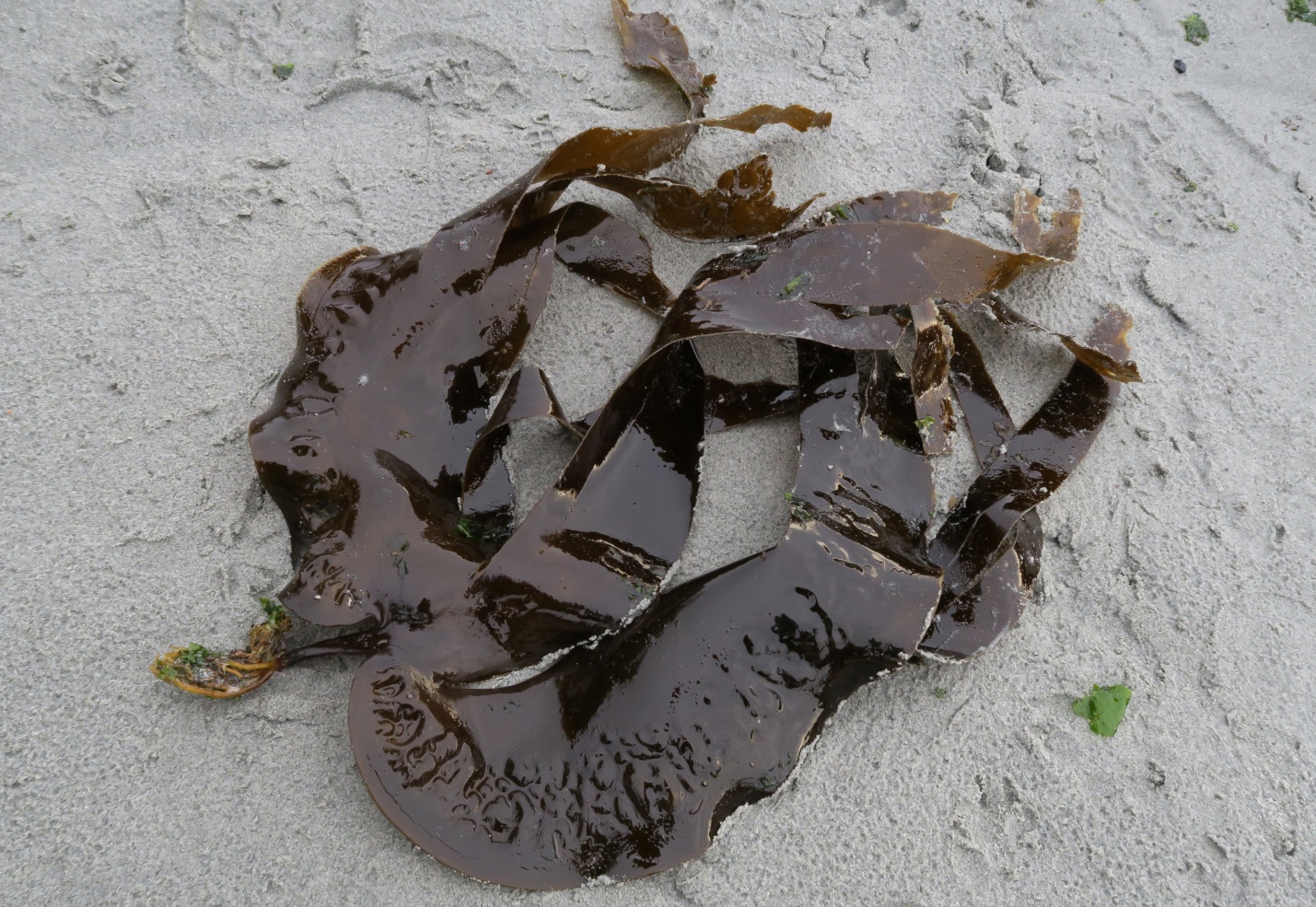
Figure 1: Late fall wind storms tend to dislodge and cast ashore many seaweeds including Hedophyllum nigripes as seen above. The irregular splits of the thallus are clearly visible and the flattened and short stipe is also distinctive. Gonzales Bay, Juan de Fuca Strait, Vancouver Island, B.C., Canada. November 20, 2021. Photo ID 27761 ©Seaweedwhisperings.com
Person 1:
My initial impressions from recent interactions, memory, and looking at our photo collection:
Very dark, almost black, from a distance.
Thick, tough, and shiny.
Very large, and particularly long.
Thinking more about its structure:
Stipe is very, very short for such a big seaweed.
Stipe starts out round and orderly, then flattens out to become almost spatulate... still quite orderly. From there, the thallus seems to go into disarray, with splits in the blade happening in a rather irregular fashion.
When just exposed at very low tide or just submerged, the blades are mainly oriented on edge rather than lying flat or “swimming” flat. I see a similarity in movement to that of a school of salmon moving upstream to a spawning ground – lots of undulation and not getting anywhere fast.
Seems to be protecting something, but I can’t see or sense what that might be... I’m distracted by its size and somewhat irregularly tattered appearance.
The thickness of the blades suggests “protecting” and the shininess is certainly attractive and distracting.
In the fall, after a big storm, many Hedophyllum nigripes are washed ashore. By this point they have “cast off” most of the length of their blades and have just kept the holdfast, stipe and some blade bases. This makes me think that this seaweed has no trouble discarding “excess”.
Hedophyllum nigripes starts out with the intent to grow in perfect balanced form, but quickly learns to this balance is not physically achievable. Then it “gives up” and grows long, happily accepting the imperfection of irregularly split blades.
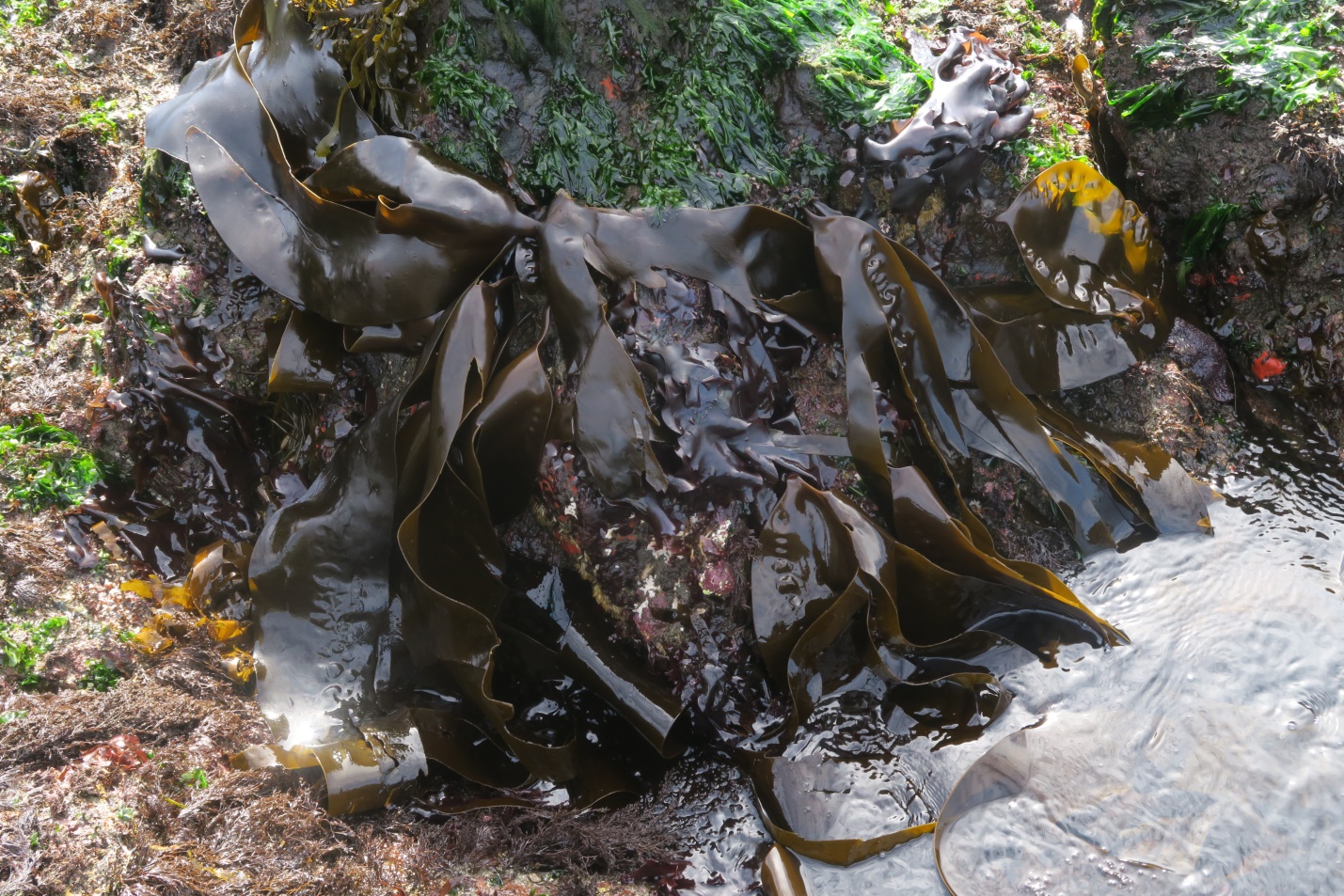
Figure 2: The deep brown, large, shiny blades of this kelp reach into the receding tide. Far more comfortable under water, this seaweed’s expanse is not often so visible. Harling Point, Juan de Fuca Strait, Vancouver Island, B.C., Canada. June 5, 2024. Photo ID 27762 ©Seaweedwhisperings.com
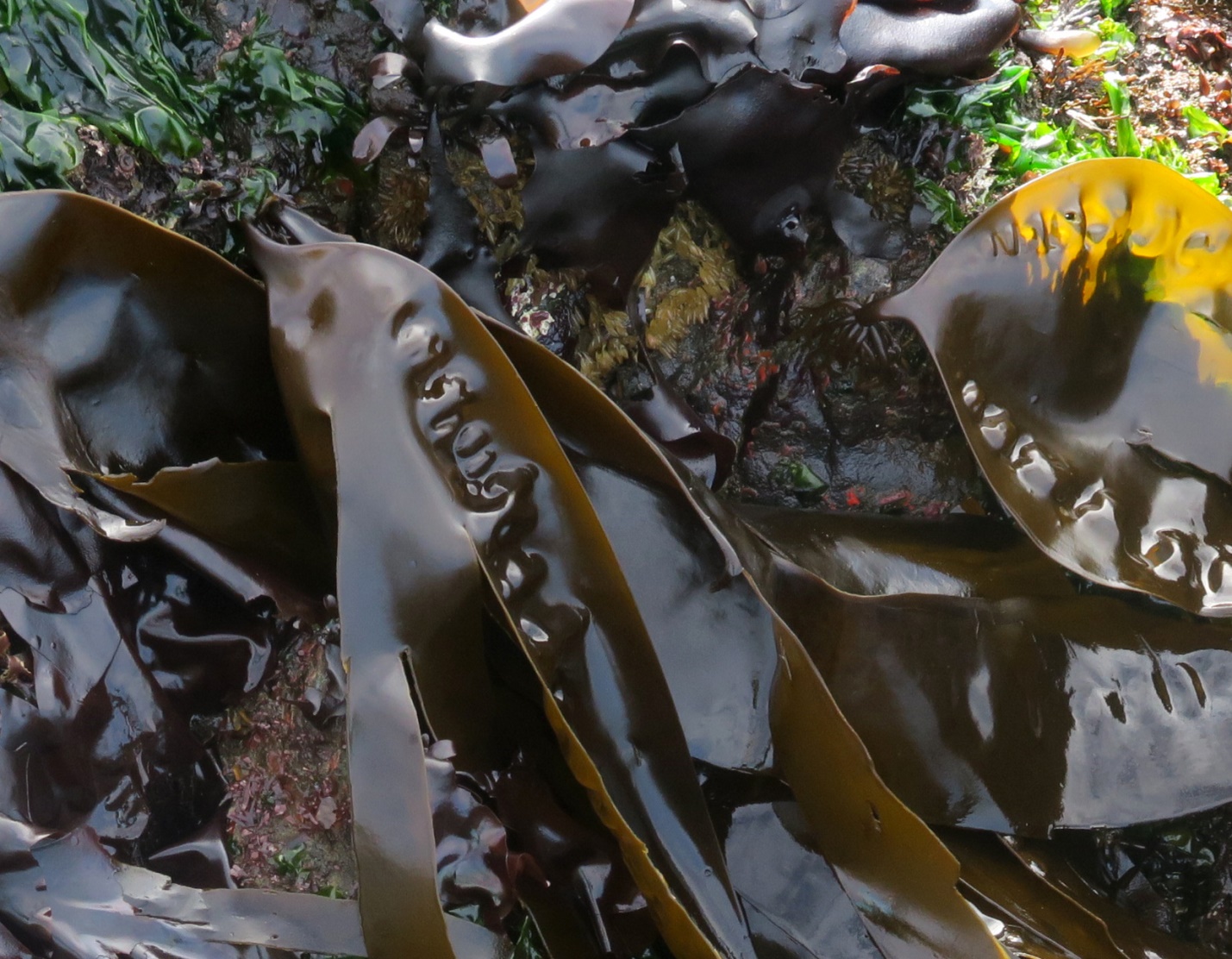
Figure 3: Zoomed in a bit, this image shows a few of the haptera/holdfasts. They are really rather small in size compared to the overall blade that they anchor. Harling Point, Juan de Fuca Strait, Vancouver Island, B.C., Canada. June 5, 2024. Photo ID 27763 ©Seaweedwhisperings.com
Person 2:
This kelp is somewhat retiring – it is not growing atop wave splashed rocks, and it doesn’t raft up and float on the ocean surface. No, this kelp grows at the very, very low intertidal and at the shallow subtidal regions attached to rock. Even though very large in size, it can be quite effectively hidden or overshadowed by other seaweeds growing just a bit higher in the intertidal zone. And its color, a deep brown, even a dark chocolate brown, is a color that doesn’t stand out (in most light conditions) under water – instead it becomes one with the shadows. So, yes, retiring, hidden, and at home with the shadows..., these are all facets of this kelp.
It has finger-like haptera that form its holdfast connecting it firmly to rock and then it has a short and sturdy stipe. Right at the holdfast the stipe is fully cylindrical, like a strong climbing rope, but almost immediately this shape is given over to be more flattened. Somehow it feels to me that this flattening is the result of the blunt realization of the very big job it will be to host the considerable growth of this seaweed’s blade. A big job, most certainly.
Indeed Hedophyllum nigripes does grow a very big blade. It spreads out like a super large and very broad bladed garden spade, but one with beautifully curved ‘corners’. The blade itself is not just large but also thick; it has real substance to it and often has bullate sections running its length, although the bullate aspect is rather irregular and does not set a particular defining pattern.
Most of the time this broad blade does not remain entire but becomes irregularly split along its length. And its length can be substantial – several meters.
When the blade is split and wafting in the ocean it has nothing to keep it up high in the water closest to the light; it has no floats (like some other kelp species do). It must rely instead on the movement of some currents and ocean swells and tidal shifts to help it move and mingle in the crowded shallow subtidal zone.
It’s interesting that in almost all physical ways this seaweed does NOT seem weak, in fact it is thick, and big, and sturdy; but it also doesn’t seem to have..., the term that comes to mind is odd but I’ll write it anyway, it doesn’t seem to have “self-propulsion”.
One doesn’t expect a seaweed to “swim” or propel itself away from its anchored home (in fact we usually reserve those words to describe the actions of animals), but with the lack of propulsion to this species I think what I sense is the opposite of assertive energy, and this idea interestingly brings me back to the original description I noted for this seaweed – “retiring”. Other words besides retiring could include meek, unassuming, modest, shy and diffident. This seems to be its way to be in life, and it is quite plainly embraced by Hedophyllum nigripes.
In the mature blades the shape near the stipe and base of the blades is cordate, or heart-shaped. When I look at this it feels as if there is such strong growth, or so much growth going on here at the base of the blade that it ‘spills over’ or ‘bulges’ into a more generous shape. Maybe it comes close to a feeling that there is much to be contained, almost constrained; it is as if its energy is held up a bit and is somehow retained in one area or diverted to this place for some reason. I think there is strength here and power, but it is contained. Contained power.
In the water the blade, torn into unequal width ribbons, has a long reach. What is it reaching for? Is it carrying, relaying, communicating..., something from its base to the tip? Or the reverse?
The blade is very smooth, both to look at and to touch. Smooth, dark, satiny brown. I think it slips in and slides through and can be barely noticed, if that is what it chooses.
And its deep, dark brown color is one that you can almost be ‘pulled into’ – it has depths and qualities that feel both sizeable and compelling.
This seaweed feels no need to be loudly visible, but there are also perhaps some aspects they want to hide or keep tucked well away and private to themselves. The privilege must be earned, to really get to know them.
They’re big, but also deeply torn. Will others see only the tears and not their strong growth?
Will some see their deep and dark brown color and presume they are shadowy and unfathomable characters at their core? Missing their generous heart...?
Will they be seen as weak and sinking into the depths, instead of peace-loving and conflict-averse souls?
It seems that this seaweed presents in a way that can promote easily made superficial conclusions regarding their true nature, and that may naturally deflect the attention of those ill-equipped to enter the shadowy regions to see what is reserved within Hedophyllum nigripes. It is not necessarily dark, what is found there, but equally it is not put out on show.
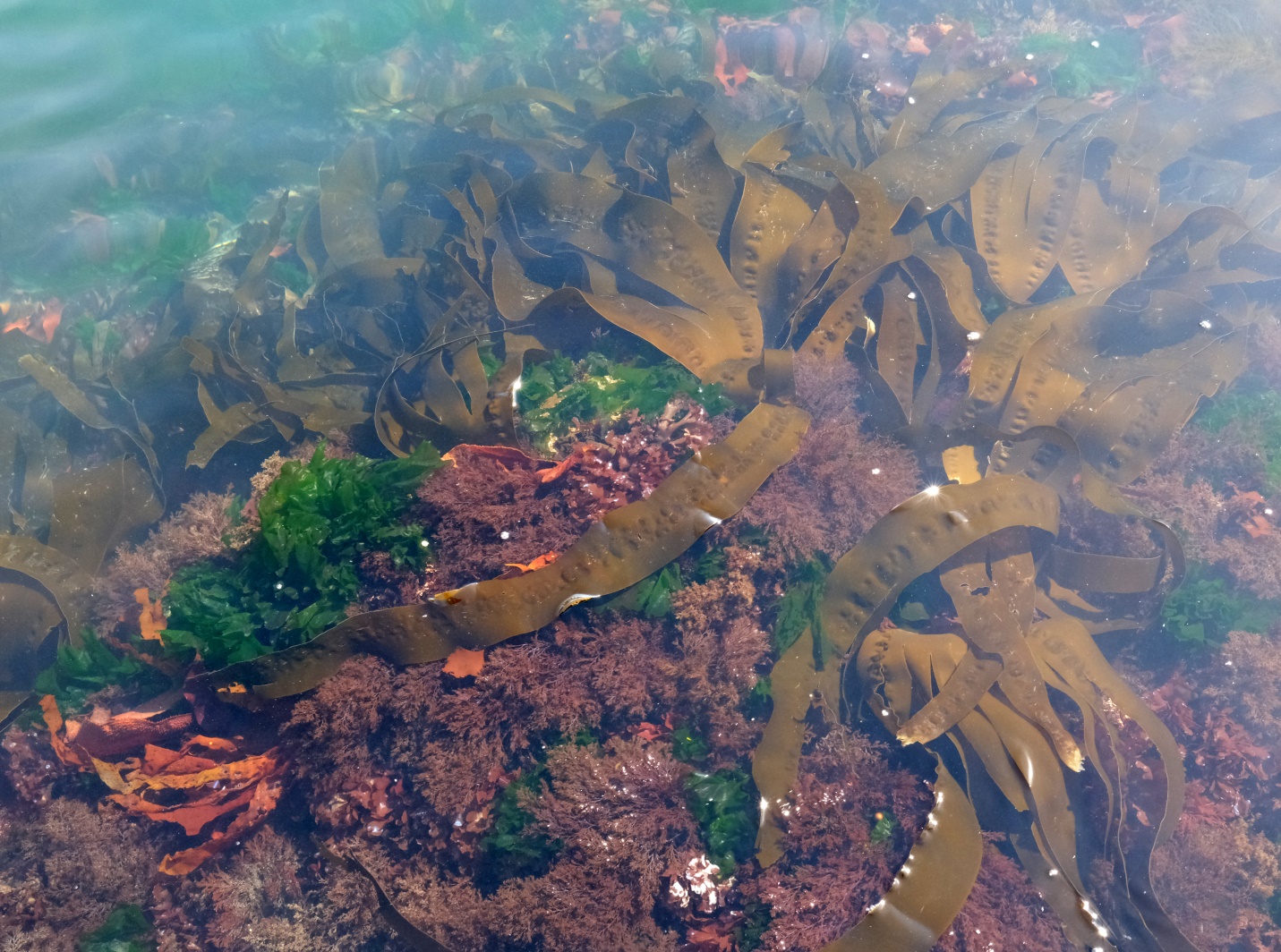
Figure 4: A view looking down into the waters of the bay – here there are several Hedophyllum nigripes individuals. Some are split into three ribbons, others into five or six, and most show some bullate texturing on the outermost edges of the very broad blades. The color of the blades through the water looks more golden than out of water. Gonzales Bay, Juan de Fuca Strait, Vancouver Island, B.C., Canada. April 22, 2022. Photo ID 27764 ©Seaweedwhisperings.com
Discussion:
Hiding or hidden. Shadowy depths. These qualities are alluded to in the Latin species name. ‘Niger’ combined with ‘pes’ makes ‘nigripes’ meaning “black foot”.
Retiring..., feet..., feet not stepping forward in the light but retiring into the blackness..., you follow their tracks and it can seem dark and obscured.
Labored movement – there can be the appearance of a lot of effort going on, but they’re not really going anywhere. In fact they don’t seem to have a clear desire to be going anywhere, almost as if they’re ‘testing the waters’ but can’t decide on a change of path.
The seaweed can appear to “mix and mingle” with others..., but it is only doing so physically. They don’t actually present much of their inner selves. This is very much like a cocktail party involving many varied guests and not an intimate dinner party with well known friends. Hedophyllum nigripes is comfortable with the cocktail party.
We had the observations in this seaweed of it being both orderly and irregular. It feels like they want to present as orderly, but life actually requires them to meet circumstances which throw them into disarray. There is another kelp species with long smooth ribbons, Laminaria setchelli, and its blade divisions are always present and remarkably equally sized. Hedophyllum nigripes has no such form; sometimes the blade is entire, sometimes there are 3 divisions, sometimes 6, sometimes one is very broad, sometimes a few seem similar in width, but the divisions are more a result of an external influence than an internal design imperative.
There’s a contrast with H. nigripes and Alaria marginata; both are long seaweeds. Alaria has a confidence and directness to its being and doesn’t easily fall apart. H. nigripes may not literally fall apart, but they rarely can keep their form intact, and the longer they live the more obvious this becomes. To be fair, H. nigripes has a much larger breadth than A. marginata; quite probably this makes more of a target impinging forces that have an impact and leave a mark.
This seaweed is very good at protecting from view that which they do not want observed. Their size and certain movements can serve as a diversionary tactic... they can easily divert attention. However, the smooth and shiny expanse of their deep brown color can also be compelling – hinting that there is actually much to them; again, this is kept deep beneath the surface and well away from casual observation.
No ‘trouble’ discarding excess..., this is true and also they see the ‘necessity’ and the ‘benefit’ of discarding excess. This is obvious with their physical size being quite regularly trimmed down by external forces in their watery world, but they are good at discarding information, thoughts, emotions and other aspects that don’t serve them, too.
When safely immersed in the shallow subtidal, this seaweed has a rather large presence..., it is easy for kelp crabs and small fish and other life forms of all kinds to hide under their sizeable blades. Hedophyllum nigripes is not actively promoting or advertising this ‘protection’ and ‘shelter’ but rather it feels like this is simply another manifestation of its strong association with shadows – its very existence creates shadows for others to make use of, too.
Making use of shadows – this can be for the purposes of ‘good’..., and sometimes it obfuscates the good --- Hedophyllum nigripes understands this concept very well.
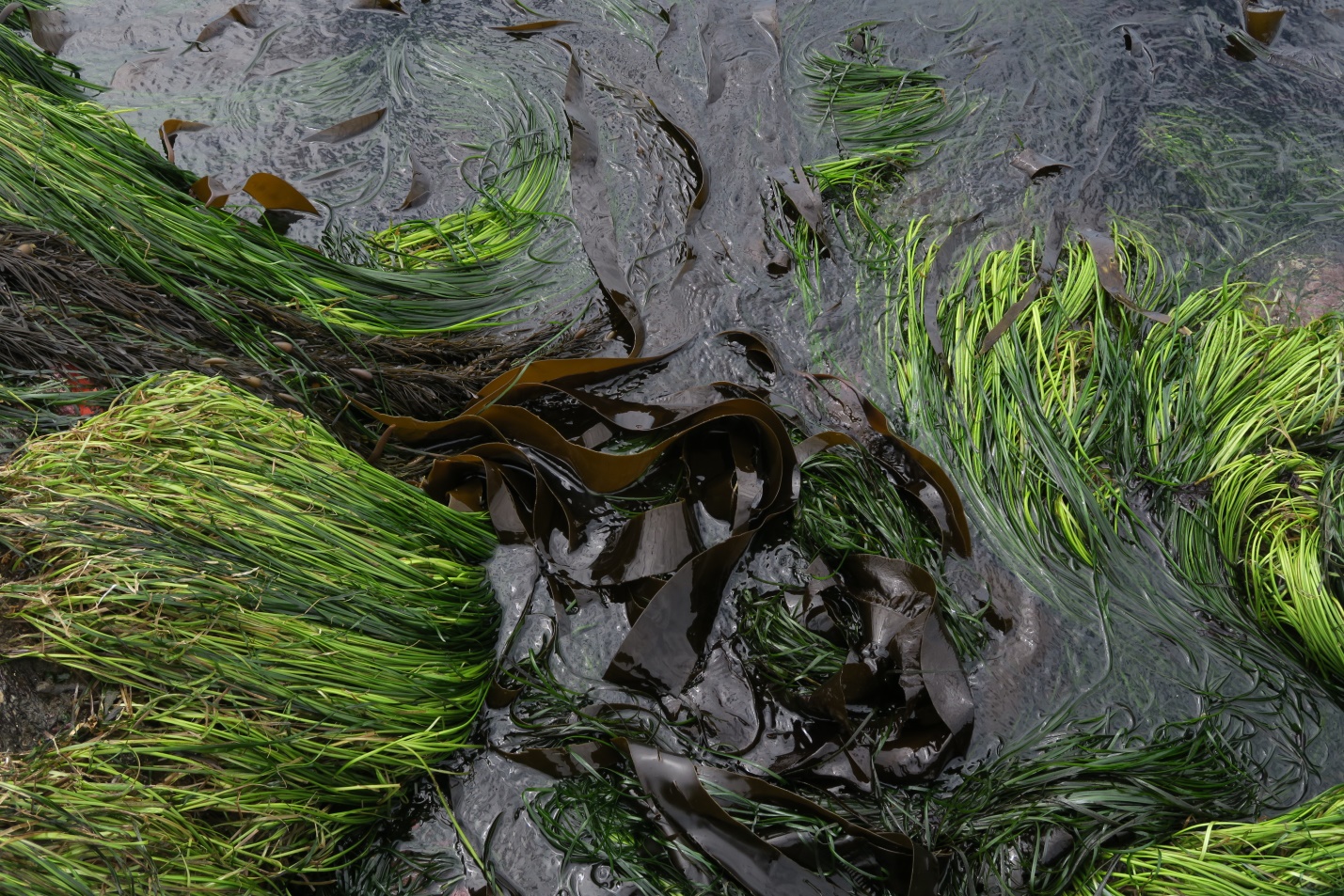
Figure 5: At very low summer tides, if you look closely near the waterline you may see this kelp which is typically more hidden in the shadows. The individuals here have split into several longitudinal ribbons and they curled and extended, curled and extended, in rhythm with the seagrass and the breaking water. Gonzales Bay, Juan de Fuca Strait, Vancouver Island, B.C., Canada. June 23, 2020. Photo ID 27765 ©Seaweedwhisperings.com
Biology & Natural History Information:
Description:
This very dark brown kelp species can have a large blade, up to 2 meters in length that grows from a rather small but highly branched holdfast. Its distinctive blade is very broad, up to 40 cm, and is flat and with most parts very smooth. The blade is characterized by regular to irregular, shallow to deep, longitudinal divisions; often it is divided into two or three segments (or more). In the Arctic and NW Atlantic, blades are typically divided, while in British Columbia it has been found that individuals with entire blades can more commonly occur. There is no midrib and the base of the blade is broadly rounded to heart-shaped. The blade can be bullate, even quite densely, when young but becomes thicker and smoother with age. The unbranched stipe is cylindrical at the holdfast but flattened at the base of the blade. Internally the stipe contains somewhat large “empty” cells called mucilage ducts that form in the second year of growth. Presence of these ducts distinguishes this kelp from a near relative, Saccharina latissima (Sugar Kelp). The sporophytes are perennial and sporangia are produced in indistinct patches on both surfaces of the blade.
Habitat:
This perennial kelp is found on rock in the low intertidal to shallow subtidal. It occurs on the outer coast and in more protected waters, preferring somewhat sheltered locations.
Distribution:
In the NW Atlantic this is a more northerly species but this kelp is widely distributed in BC. It also occurs in the Bering Sea and Aleutian Islands, Alaska, and down the pacific coast to central California; Russia.
Classification:
Class: Phaeophyceae
Subclass: Fucophycidae
Order: Laminariales
Family: Laminariaceae
Genus: Hedophyllum
Species: Hedophyllum nigripes (J.Agardh) Starko, S.C.Lindstrom & Martone 2019
Former name(s): There are numerous synonyms, both homotypic and heterotypic; we refer the reader to AlgaeBase.org for more details.
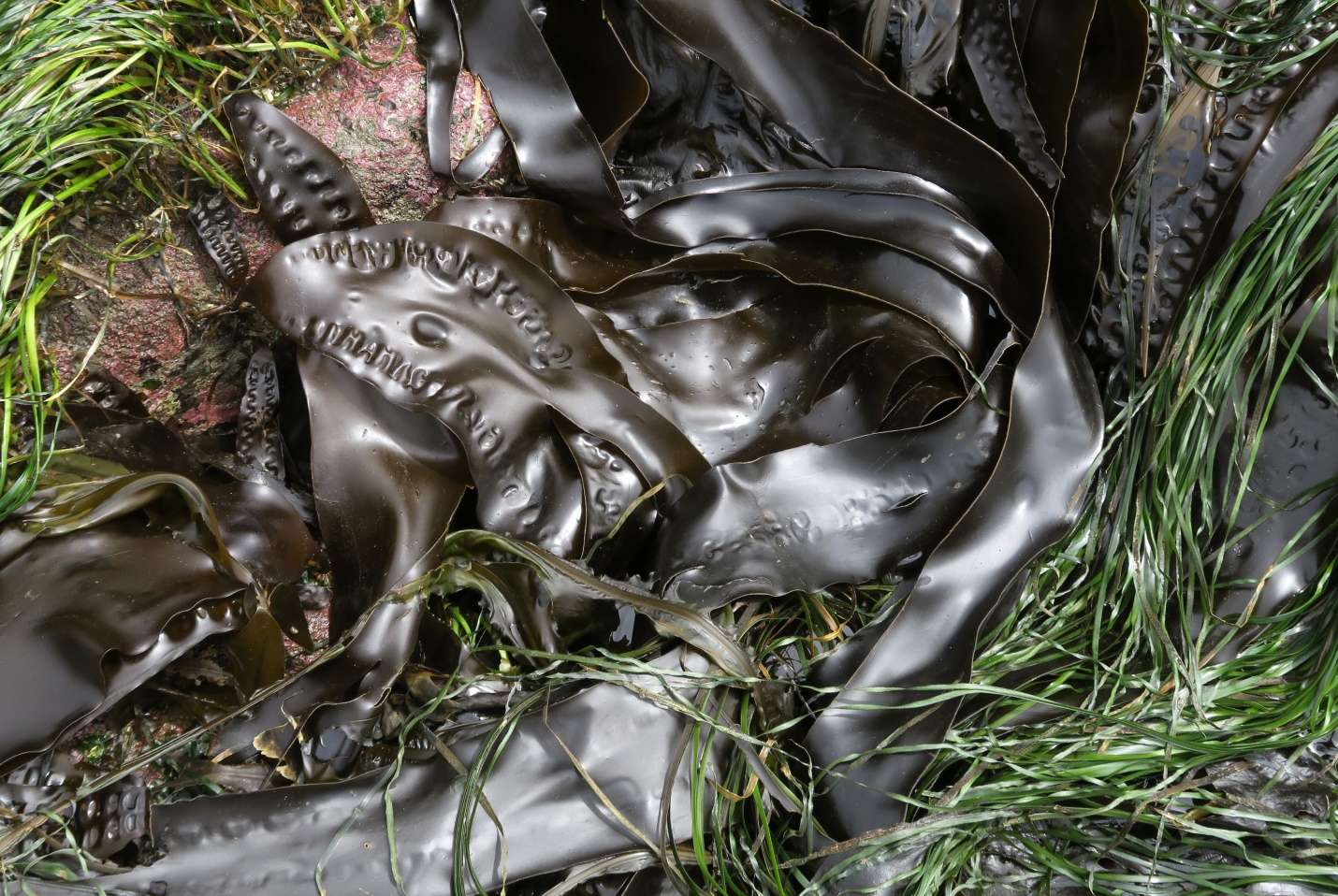
Figure 6: This photo shows a variety of sizes/ages of the species. The deep brown and smooth texture of the blades is compelling. Harling Point, Juan de Fuca Strait, Vancouver Island, B.C., Canada. June 23, 2020. Photo ID 27766 ©Seaweedwhisperings.com
![]()